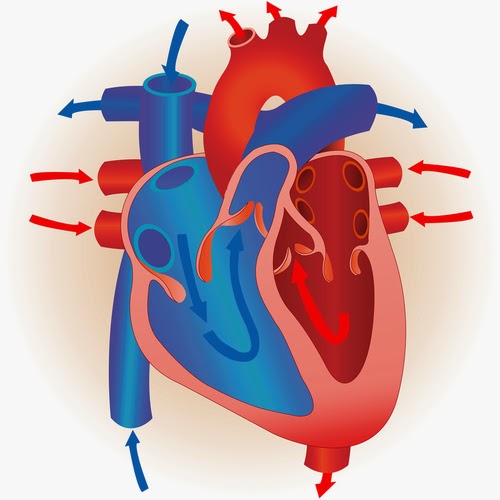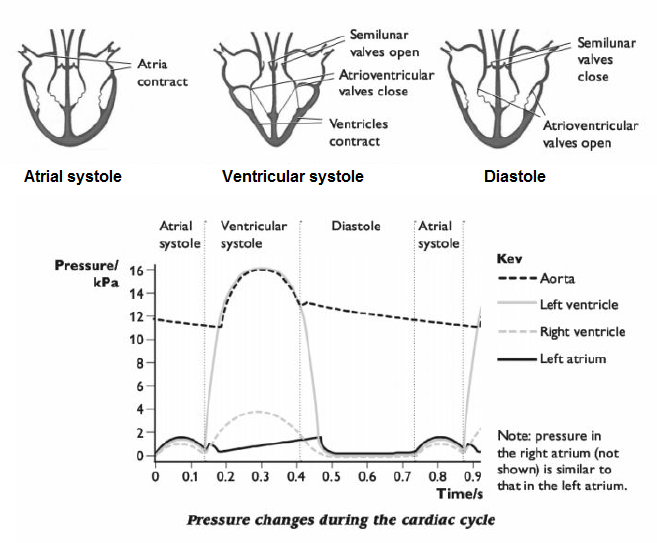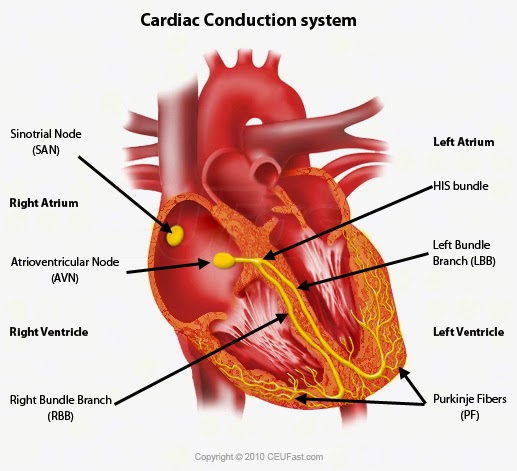Biology
 The mammalian heart is a double pump:
The mammalian heart is a double pump:

Initiation and control of the cardiac cycle
Cardiac muscle is myogenic - it contracts and relaxes automatically, without the need of stimulation by nerves. The rhythmic, coordinated contraction of the cardiac muscle in different parts of the heart is coordinated through electrical impulses passing through the cardiac muscle tissue.

- #83 Question 6
The diagram below shows pressure changes in the left atrium and left ventricle of the heart and the aorta during the cardiac cycle. (a) Calculate how many heart beats there will be in one minute. (2 marks)(b) (i) On the diagram, indicate the point at...
- # 44 The Circulatory System - Blood Vessels
The mammalian circulatory system is a closed double circulation, consisting of a heart, blood vessels and blood. The heart produces high pressure --> blood moves through the vessels by mass flow. The mammalian...
- #43.2 Transport In Mammals - Syllabus 2016
8.1 The circulatory system 8.2 The heart As animals become larger, more complex and more active, transport systems become essential to supply nutrients to, and remove waste from, individual cells. Mammals...
- #43.1 Transport In Mammals - Syllabus 2015
? The need for, and functioning of, a transport system in mammals ? Structure and functioning of the mammalian heart Learning Outcomes Candidates should be able to: (m) [PA] describe the structures of arteries, veins and capillaries and be able to...
- Body Fluids And Circulation
Click here for PDFCirculation is the transport of nutrients, oxygen, CO2 and excretory products to the concerned tissues or organs.For circulation, simple organisms (sponges, coelenterates etc) use water from their surroundings....
Biology
#46 The Heart

- The right side pumps deoxygenated blood at low pressure to the lungs.
- The oxygenated blood then returns to the left side of the heart in the pulmonary vein.
- The left side pumps oxygenated blood at high pressure to the rest of the body in the aorta.
- The blood then returns to the right side of the heart in the vena cava to start the cycle again.
Structure of the mammalian heart
The External Structure

The Internal Structure

The cardiac cycle
The External Structure

- The mammalian heart is a hollow organ and is surrounded by a double membrane, called the pericardium.
- The space between the 2 membranes is filled with a watery fluid which prevents friction when the heart beats.
- A transverse and a longitudinal groove are visible on the surface of the heart. These grooves indicate the positions of the inner walls which divide the heart into 4 chambers: 2 upper chambers (atria), and 2 larger lower chambers (ventricles).
- The coronary arteries and veins are clearly visible on the grooves.
- Entering the right atrium are the superior vena cava and the inferior vena cava.
- Entering the left atrium are the 4 pulmonary veins.
- From the upper central portion of the heart arise the pulmonary artery with a right and left branch and the aorta with its branches.
The Internal Structure
- A muscular septum divides the heart internally into a left and a right half. Each half is subdivided into 2 chambers, the atrium (reception) and the ventricle (pump chamber) . Internally all 4 chambers have a smooth membranous lining, the endocardium.
- The atria and ventricle on the left side of the heart contain oxygenated blood, while those on the right side contain deoxygenated blood.
- The walls of the heart are made of cardiac muscle.

- The walls of the ventricles are thicker than those of the atria as they have to produce more pressure.
- The wall of the left ventricle is thicker than the wall of the right ventricle as it has to produce enough pressure to move blood all around the body, not just to the lungs.
The cardiac cycle
- Heart is two pumps that work together. Both sides of the heart contract and relax together.
- Repetitive contraction (systole) and relaxation (diastole) of heart chambers.
- Blood moves through circulatory system from areas of higher to lower pressure.
- Contraction of the cardiac muscle causes the walls to squeeze inwards on the blood inside the heart --> produces the pressure.
- During atrial systole, the muscles in the walls of the atria contracts, pushing more blood into the ventricles through the open atrioventricular valves.
- During ventricular systole, the muscles in the walls of the ventricles contract. This causes the pressure of the blood inside the ventricles to become greater than in the atria, forcing the atrioventricular valves shut. The blood is forced out through the aorta and pulmonary artery.
- During diastole, the heart muscles relax. The pressure inside the ventricles becomes less than that inside the aorta and pulmonary artery, so the blood inside theses vessels pushes the semilunar valves shut. Blood flows into the atria from the veins, so the cycle is ready to begin again.

Cardiac muscle is myogenic - it contracts and relaxes automatically, without the need of stimulation by nerves. The rhythmic, coordinated contraction of the cardiac muscle in different parts of the heart is coordinated through electrical impulses passing through the cardiac muscle tissue.
- In the wall of the right atrium, there is a patch of muscle tissue called the sinoatrial node (SAN). This has an intrinsic rate of contraction a little higher than that of the rest of the heart muscle.
- As the cells in the SAN contract, they generate action potentials (electrical impulses) which sweep along the muscle in the wall of the right and left atria. This causes the muscle to contract. This is atrial systole.
- When the action potentials reach the atrioventricular node (AVN) in the septum, they are delayed briefly. They then sweep down the septum between the ventricles, along the left and right bundle of His to the respective Purkyne fibers, and then up through the ventricle walls. This causes the ventricles to contract slightly after the atria. The left and right ventricles contract together, from the bottom up. This is ventricular systole.
- There is then a short delay before the next wave of action potentials is generated in the SAN. During this time, the heart muscles relax. This is diastole.

Syllabus 2015 (t) describe the external and internal structure of the mammalian heart; (u) explain the differences in the thickness of the walls of the different chambers in terms of their functions; (w) describe the cardiac cycle (including blood pressure changes during systole and diastole); (x) explain how heart action is initiated and controlled (reference should be made to the sinoatrial node, the atrioventricular node and the Purkyne tissue); |
Syllabus 2016 8.2 The heart The mammalian heart is a double pump: the right side pumps blood at low pressure to the lungs and the left side pumps blood at high pressure to the rest of the body. a) describe the external and internal structure of the mammalian heart b) explain the differences in the thickness of the walls of the different chambers in terms of their functions with reference to resistance to flow c) describe the cardiac cycle (including blood pressure changes during systole and diastole) d) explain how heart action is initiated and controlled (reference should be made to the sinoatrial node, the atrioventricular node and the Purkyne tissue, but not to nervous and hormonal control) |
- #83 Question 6
The diagram below shows pressure changes in the left atrium and left ventricle of the heart and the aorta during the cardiac cycle. (a) Calculate how many heart beats there will be in one minute. (2 marks)(b) (i) On the diagram, indicate the point at...
- # 44 The Circulatory System - Blood Vessels
The mammalian circulatory system is a closed double circulation, consisting of a heart, blood vessels and blood. The heart produces high pressure --> blood moves through the vessels by mass flow. The mammalian...
- #43.2 Transport In Mammals - Syllabus 2016
8.1 The circulatory system 8.2 The heart As animals become larger, more complex and more active, transport systems become essential to supply nutrients to, and remove waste from, individual cells. Mammals...
- #43.1 Transport In Mammals - Syllabus 2015
? The need for, and functioning of, a transport system in mammals ? Structure and functioning of the mammalian heart Learning Outcomes Candidates should be able to: (m) [PA] describe the structures of arteries, veins and capillaries and be able to...
- Body Fluids And Circulation
Click here for PDFCirculation is the transport of nutrients, oxygen, CO2 and excretory products to the concerned tissues or organs.For circulation, simple organisms (sponges, coelenterates etc) use water from their surroundings....
